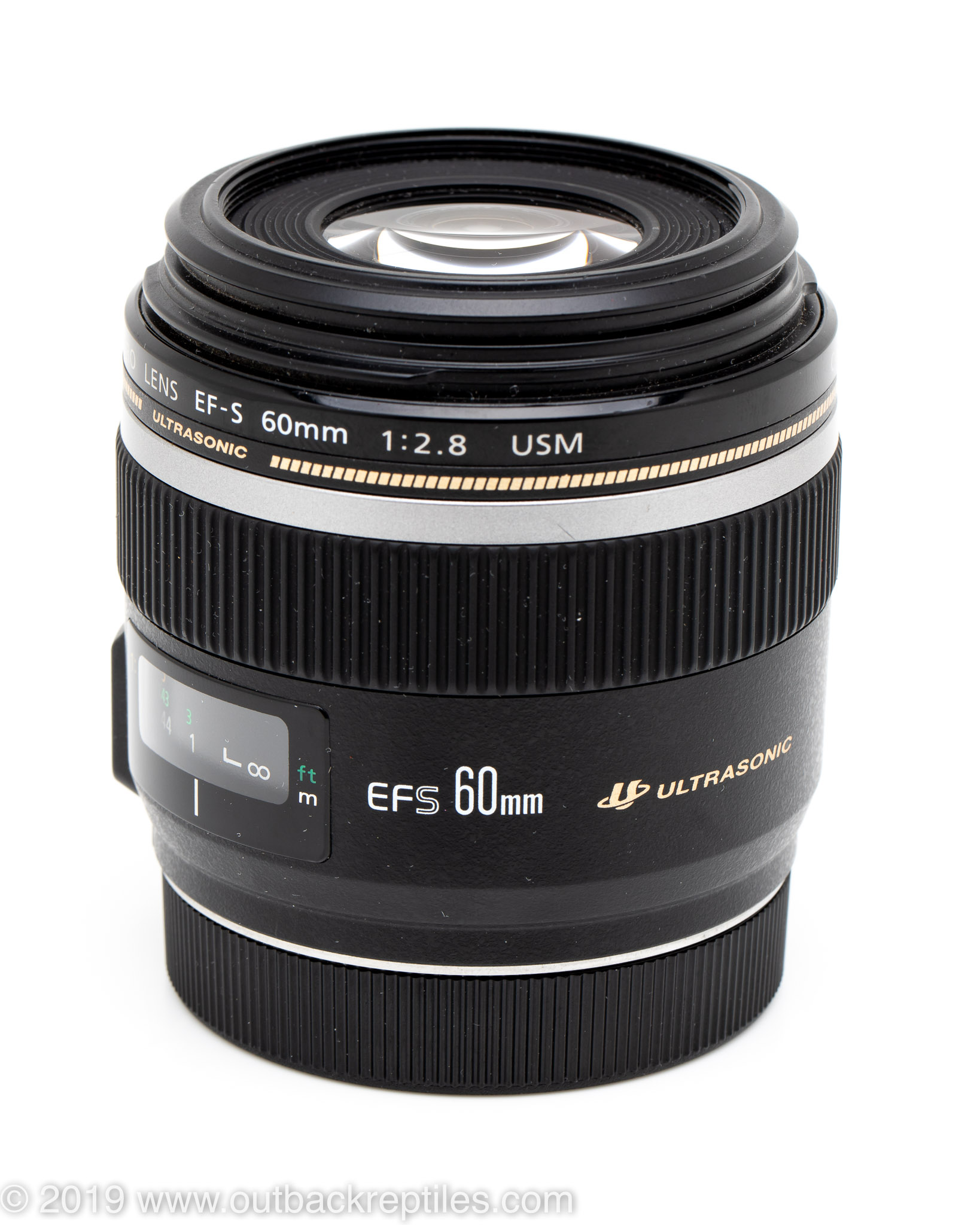If you’ve followed this website, our facebook page, or my personal page then you know I am really into macro photography. When the hours are long, the job is hard and my body aches, I know that at the end of the day my camera is waiting for me and she is always kind to me. Unlike my friends. They’re mean, and hate me. So there’s nothing quite like a fine piece of precision equipment that does exactly what it’s supposed to, and does so with flying colors.
So what do I rely on to save myself from losing my weak grasp on sanity after a long day of frustration? Obviously I cannot task some unreliable piece of junk with this important job, so I need to make sure I use the best equipment possible. So almost exclsuively, for the vast majority of reptile photos I take, my hands down favorite lens is the Canon EF-S 60mm Macro lens.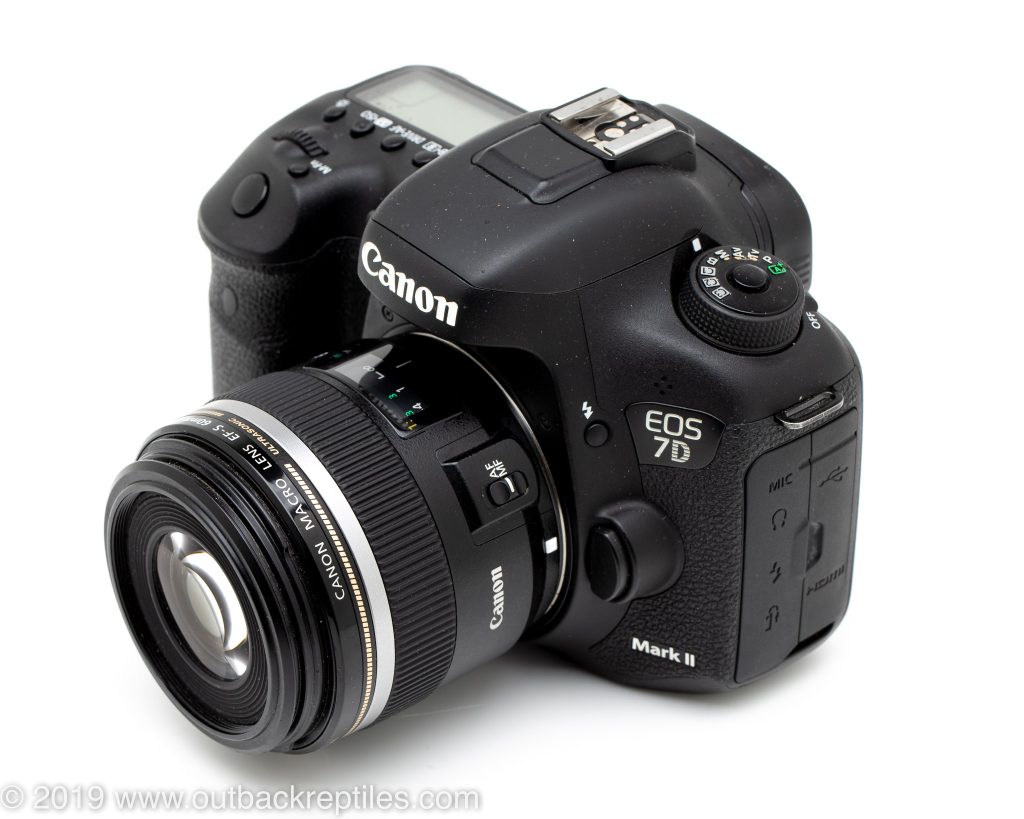
This is an unbiased Canon 60mm macro lens review- I am praising this lens quite a bit, but this simply because it is such a fantastic lens. I will be adding more lens reviews at some point but this one is certainly my very favorite workhorse lens that I use pretty much every day. I paid for this lens retail and did not receive any compensation for this review. I do link to the product in this ad several times – these are affiliate links that give me a bonus for directing people to purchase them. The cost is the same to you as if you had found the product yourself- amazon just gives me a few cents if people buy through my links, so please do so if you intend on buying them! This helps support free content (such as this article) that I am providing you.
So why would I recommend this inexpensive lens compared to Canon’s higher end offerings such as the 100mm L lens? Well, simply, this lens is made for a Crop Sensor (APS-C) camera body. This includes all canon Rebels, the 60D, 70D, 80D, Canon 7D and 7D mark II (which I use). So basically, this lens is designed specifically for any and all entry or mid range Canon cameras, and as a result of that it tends to be a much better choice if you own one of these cameras. And for simple studio work such as macro snake photography, a full frame camera is a little bit overkill – a crop sensor is cheaper and will produce nearly identical looking images if used correctly.
Here’s a diagram showing the difference between a “Crop sensor” (APS-C) and a “Full frame” sensor and how they work on an image. If I use the same full frame lens (Say, the 100mm) on both a full frame body and a crop body, you can see that the smaller “crop” sensor camera only utilizes part of the image that the lens circle produces. This effectively “crops” the image, giving it the effect of “zoooming in.” So if I want to take the same photo with a 100mm lens on a crop cameras as I would on a full frame camera, i’d have to step back a bit to compensate for that cropped in effect. Whereas a smaller lens with a shorter focal length of 60mm, tends to fit the sensor almost the same as the 100mm fits the full frame camera.
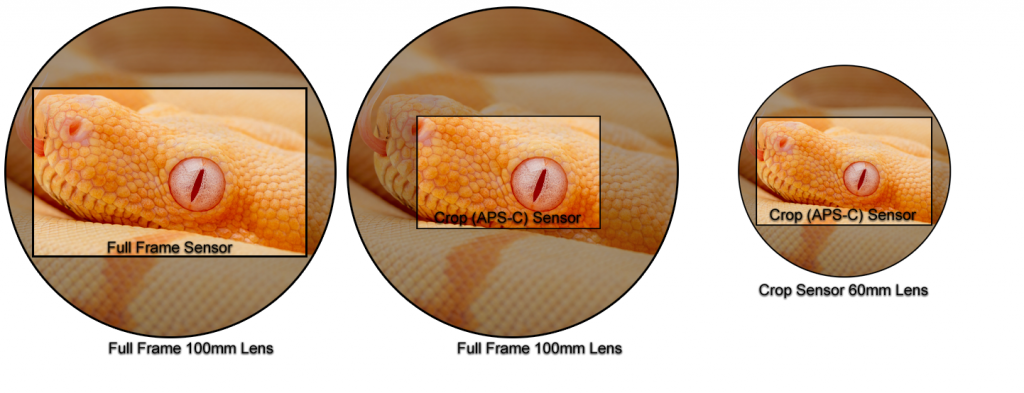
This is why I prefer the Canon EF-S 60mm macro lens on my crop sensor body, and the 100mm macro lens on my full frame body. Shooting 60mm on a crop sensor body gives ample working distance so that I can take closeup shots of small features (eyes, claws, etc) as well as full-on body shots from merely an arm’s distance away. With a 100mm lens, on a crop body, I have to stand 4 feet away from my subject to get full body shots! A lot more difficult to keep squirmy animals in place if I am running back and forth for each shot.
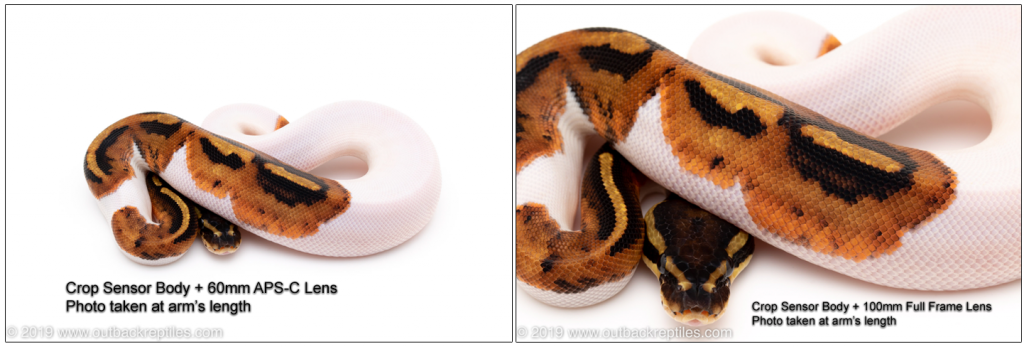
Here is an actual example where I took the same photo of the same snake, with the same crop sensor camera (7D mark 2), but I used both my 60mm crop lens and my 100mm full frame lens. Neither of these images was cropped or zoomed in any way- I just stood in the same spot, switched lenses, and took the same picture. As you can see, I’d have to step back quite a bit to fit the whole snake in frame as I could easily do at arm’s length with the 60mm lens.
Now, just because this lens is less expensive and designed for less expensive cameras, does not mean the quality of the lens suffers in any way. make no mistake – this is a Canon professional grade “L” lens in disguise. The key features of any macro lens are the ability to focus a lot closer to the front of the lens than your average “normal” use lens, and razor sharp images. Typically they will also produce a 1:1 magnification ratio- which means, at the closest focusing distance, the image will be the exact same size on the sensor as it is in real life. This lens checks all those boxes, with a 1:1 magnification ratio, a very close minimum focusing distance of about 7 inches from the sensor (so more like 4-5 inches from the front of the lens) and it is sharp as a tack.
This macro lens is also built very well. It has a metal lens mount and nice high quality plastic body shell. This, along with it being a smaller lens designed for that smaller sensor, means it is lightweight and easy to use. The lens is not weather sealed, but hey, for indoor photography this should not be an issue. If you’re having trouble with water getting inside your lens during a studio shoot, you should call a plumber or perhaps a roofing contractor!
Autofocus on the Canon 60mm macro lens is snappy and accurate. The USM Autofocus system (Ultra-Sonic Motor) means it has a tiny, silent motor inside the lens to ensure quick autofocus without a lot of noisy gears churning.
Now that I have finished singing its praises, I do have to list some drawbacks of this lens. They are minor but they do exist and this would not be a fair review if I didn’t outline those as well.
First, if you wish to use a full frame camera rather than a crop sensor camera, this lens is not compatible. The back of the lens is designed to fit on Crop Sensor canon cameras but not Full frame. Now, this is not such a big deal, as a 100mm full frame lens on a full frame camera, operates very similar to how this 60mm lens works on a crop sensor camera. But you’ll be paying more for those lenses typically, as they have more glass and materials involved (as well as engineering) in making the larger lens.
Second, is for extreme macro shots. The 60mm lens, having such a closer working distance, can be a little finicky if you’re taking photos of subjects very very close to you. For example, if you decide to use extension tubes to decrease the minimum focusing distance (I will write a tutorial on their use in the future, make sure to check back!), this can make it difficult to get light on your subject. If you are photographing an insect a few centimeters away from the glass, the lens itself can actually block light from illuminating that insect and make it more difficult to take the photo. So for this reason, I actually do prefer a longer focal length like 100mm when photographing extreme macro subjects in the field.
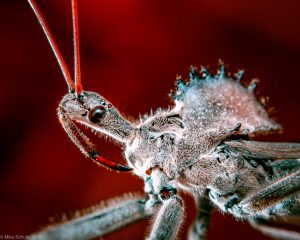
But I will also mention that, for extreme macro photography, the Canon 60mm lens tends to multiply magnification more when using extension tubes, due to that shorter working distance to start with. So if you have the right lighting solutions to illuminate subjects very close to your lens, the 60mm lens can actually be a very powerful tool for extreme macro as well.
Now, after all this is said and done, we all do have our own preferences and style. So this lens may be perfect for you or it may be the exact opposite of what you need, depending on how you shoot. I urge everybody to try renting or borrowing a lens before buying, if you aren’t sure it’s what you’ll need. There are several big name online rental houses as well as piles of local shops that will allow you to rent equipment. Try before you buy and you won’t be disappointed. Regardless, I’m positive that anybody looking to photograph reptiles with a crop sensor canon camera will absolutely love this lens.
Good luck and happy shooting!
~Mike

